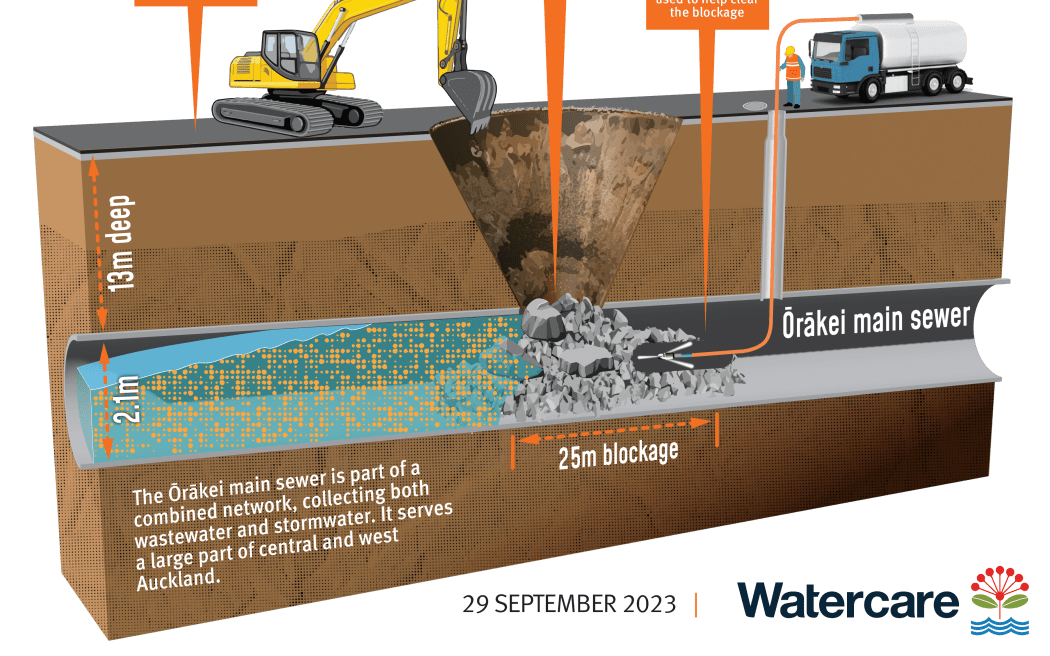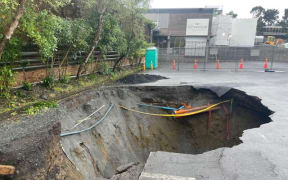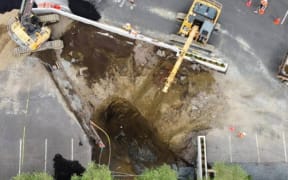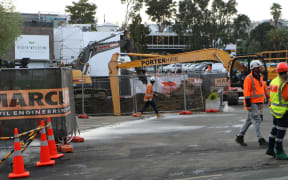
The sinkhole in Parnell. Photo: Watercare
Auckland needs to urgently address old infrastructure if it wants to avoid further water contamination, an environmental ecologist says.
Tonnes of debris has been removed from the blocked pipe where a 13-metre deep sinkhole opened in Parnell a week ago, with hundreds of litres of sewage per second being pumped into the Waitematā Harbour since.
Watercare postponed until Tuesday the laying of a temporary pipeline to reduce the wastewater overflow.
The pipeline was expected to go in on Monday, but Watercare said crews spent the day preparing the ground.
Victoria University ecology and environmental science senior researcher Dr Mike Joy said the problem was not new.
"This is in the news because it's a big one, but wastewater has been leaking from the broken infrastructure in Auckland as it is in many cities in New Zealand for a long time and much smaller levels.
"At least over the last two decades I've seen many of the broken pipes and slow discharges into streams."
He said the issue was a result of aged infrastructure that had never been updated.
"This is just a spike in an ongoing failure of critical sewage infrastructure. Some of those pipes and networks are ancient and Auckland is growing incredibly fast and not keeping up with that."

This diagram shows the impact of the sinkhole on the Ōrākei main sewer. Photo: Watercare
Watercare said until the bypass was completed, hundreds of litres of waste per second were being pumped into the Waitematā Harbour.
"The amount of wastewater in this part of the network fluctuates throughout the day, as the volume increases during wet weather and decreases in dry weather.
"We don't have flow meters at the overflow locations, so our best estimate of the overflow volume is that it's several hundred litres per second. It's a high-volume overflow and we're doing everything we possibly can to put an end to it as soon as possible."
Joy said the contamination could have serious effects on the sea life.
"There are nutrients in [the sewage] that will drive algal blooms in the harbour and the waterways, which can limit the sunlight available and cause lack of oxygen in water.
"Human waste tends to be really high and some unusual things like oestrogens, some hormones and nettles, and there's often industrial waste going into these wastewater systems as well.
"That can cause big problems in the aquatic balance."
He said water life would carry damaging consequences.
"Shellfish will accumulate the pathogens from the wastewater, and those pathogens can live a lot longer inside the shellfish.
"So even when the water tests come clear for pathogens and it's safe to swim again, you can still have high levels of potentially dangerous pathogens in shellfish for a lot longer.
"It will still be unsafe to eat it for quite a long time."
Joy said the issue was ongoing and needed to be addressed urgently to avoid an even greater environmental damage.
"That's not the only place that wastewater is leaking into the harbour, there are many other points. Some of it tends to be not directly into harbour, but into the streams that flow into it, so they get flushed through when you have a big rainfall event."
The government should be taking a precautionary approach, he said.
"We have this kind of tendency to not do anything about an issue until we have to. Everyone knows how dangerous this is, and we should be upgrading the wastewater infrastructure so that it doesn't happen again.
"We need to start thinking of the longer term, climate change is here."
'Stay out of the water' - National Public Health
A global study by the World Health Organisation (WHO) estimated that bathing in polluted seas caused 250 million cases of gastroenteritis and upper respiratory disease every year.
The group of experts on the Scientific Aspects of Marine Environmental Protection - GESAMP - said most illnesses are caused by pathogens.
"They cause a wide variety of acute illnesses including diarrhoea, cholera, dysentery, typhoid, and hepatitis A.
"Pathogenic bacteria can survive in the sea from a few days to several weeks, while viruses can survive in water, fish or shellfish for several months. The hepatitis virus can remain viable in the sea for over a year," it said.
Twenty-four inner-city beaches in Auckland were closed for swimming due to the wastewater overflow.
Te Whatu Ora national public health northern region medical officer of health Dr David Sinclair said the amount of different diseases that could come from contact with contaminated water was concerning.
"If people get into the water they could [get] several types of skin infections, eye and ear infections and get respiratory infections as well.
"And of course, they can also get gastroenteritis from any gastro bugs that might be in the water at the same time. That is contagious and could result in an outbreak."
He said water activities should be avoided, as well as letting pets in.
"It's preferable for people to stay out of the water until the all clear is given, including air paddling and kayaking.
"Pets too can be affected by infections as much as humans, so it's best for them to be kept away."
Fishing was also not recommended.
"Particularly not shell fishing, as they absorb those sewage nutrients for quite a while," Sinclair said.





